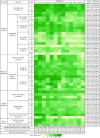Food and Nutrition Systems Dashboards: A Systematic Review
- PMID: 35254406
- PMCID: PMC9156375
- DOI: 10.1093/advances/nmac022
Food and Nutrition Systems Dashboards: A Systematic Review
Abstract
The rapid expansion of food and nutrition information requires new ways of data sharing and dissemination. Interactive platforms integrating data portals and visualization dashboards have been effectively utilized to describe, monitor, and track information related to food and nutrition; however, a comprehensive evaluation of emerging interactive systems is lacking. We conducted a systematic review on publicly available dashboards using a set of 48 evaluation metrics for data integrity, completeness, granularity, visualization quality, and interactivity based on 4 major principles: evidence, efficiency, emphasis, and ethics. We evaluated 13 dashboards, summarized their characteristics, strengths, and limitations, and provided guidelines for developing nutrition dashboards. We applied mixed effects models to summarize evaluation results adjusted for interrater variability. The proposed metrics and evaluation principles help to improve data standardization and harmonization, dashboard performance and usability, broaden information and knowledge sharing among researchers, practitioners, and decision makers in the field of food and nutrition, and accelerate data literacy and communication.
Keywords: dashboard evaluation; data visualization; nutrition and food surveillance; nutrition data quality; quality metrics.
© The Author(s) 2022. Published by Oxford University Press on behalf of the American Society for Nutrition.
Figures

References
-
- Al Jawaldeh A, Osman D, Tawfik A, World Health Organization . Food and nutrition surveillance systems: technical guide for the development of a food and nutrition surveillance system for countries in the Eastern Mediterranean region. Cairo (Egypt): World Health Organization Eastern Mediterranean Regional Office (EMRO); 2013.
-
- The Food Systems Dashboard. [Internet]. [Accessed 2020 Mar 25]. Available from: https://www.foodsystemsdashboard.org.
-
- World Food Programme . [Internet]. [Accessed 2021 Apr 28]. Available from: https://hungermap.wfp.org/.

